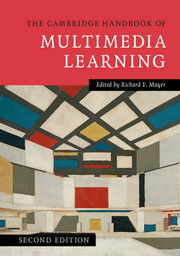Book contents
- The Cambridge Handbook of Multimedia Learning
- The Cambridge Handbook of Multimedia Learning
- Copyright page
- Contents
- Contributors
- Preface
- Acknowledgments
- 1 Introduction to Multimedia Learning
- Part I Theoretical Foundations
- Part II Basic Principles of Multimedia Learning
- Part III Advanced Principles of Multimedia Learning
- Part IV Multimedia Learning of Cognitive Processes
- Part V Multimedia Learning in Advanced Computer-Based Contexts
- Author Index
- Subject Index
Part V - Multimedia Learning in Advanced Computer-Based Contexts
Published online by Cambridge University Press: 05 August 2014
- The Cambridge Handbook of Multimedia Learning
- The Cambridge Handbook of Multimedia Learning
- Copyright page
- Contents
- Contributors
- Preface
- Acknowledgments
- 1 Introduction to Multimedia Learning
- Part I Theoretical Foundations
- Part II Basic Principles of Multimedia Learning
- Part III Advanced Principles of Multimedia Learning
- Part IV Multimedia Learning of Cognitive Processes
- Part V Multimedia Learning in Advanced Computer-Based Contexts
- Author Index
- Subject Index
Summary
Intelligent tutoring systems (ITS) are a form of computer training that attempt to simulate both human tutors and ideal tutoring strategies. Learning gains from ITS environments have been promising, showing 0.4–1.1 standard deviations of improvement in learning over traditional instruction and the reading of texts. These systems show advantages in learning over conventional computer-based instruction, which in turn show improvements over the presentation of static material. This chapter reviews highlights of these ITS advances, particularly from the perspective of multimedia. Different types of multimedia have been integrated with these tutoring systems, including materials in multiple modalities, animation, interactive simulation, and conversational agents. The chapter identifies forms of multimedia implemented in tutoring systems driven by problem solving, simulations, natural language, games, and embodied interaction. Although these types of ITS routinely incorporate various multimedia, there is not a large body of research that assesses the incremental impact of particular multimedia features on learning or that segregates the contributions of the multimedia per se versus the intelligent mechanisms of ITS. Available evidence suggests that the conceptual content that is adaptively presented and interactively experienced by the student is more important than the type of media that presents the content. It is important to align media to the knowledge, skills, and strategies targeted by ITS and to resist media features that add irrelevant activities that distract from the serious educational content. More research is needed to determine how feedback, interactivity, attention focus features, hints, and other intelligent scaffolding are optimally coordinated with multimedia.
- Type
- Chapter
- Information
- The Cambridge Handbook of Multimedia Learning , pp. 703 - 882Publisher: Cambridge University PressPrint publication year: 2014

